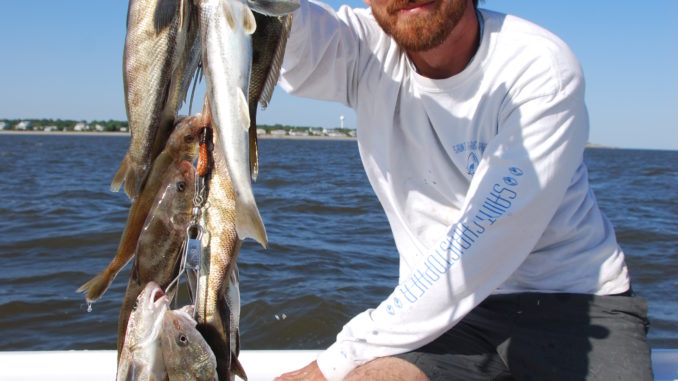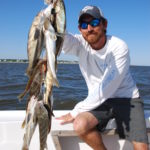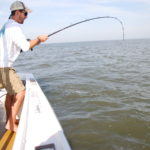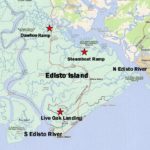
Drop a piece of fresh shrimp to the bottom of a deep hole or a piece of hard structure and hang on; dinner is on the way.
Short of watching a bobber dance before it zooms beneath the water’s surface, the feel of a weight holding tight to the bottom and a solid series of thumps is probably one of the most cherished fishing moments many of us have. Like watching the bobber, bottom-fishing for saltwater panfish is a lot of fun, very productive, and easier to do right off the beach than most people realize.
In the Palmetto State, panfish are generally classified as one of three main species that inhabit our inshore and nearshore waters: spot, whiting and Atlantic croaker. Although these fish are members of different families, they behave similarly, migrating into South Carolina waters during the summer, schooling in tight, large groups, and providing quick and easy bottom-fishing close to shore, and make excellent table fare.
For vacationing anglers visiting Edisto Beach, panfish, particularly whiting and Atlantic croaker, are a summer staple of the fishing community. Capt. Jimmy Skinner of Fontaine Charters calls whiting his “bread-and-butter” fish and puts his clients on plenty of action within sight of the beach.
“We catch plenty of these fish in the creeks, inlets and nearshore waters around Edisto Island,” said Skinner. “It’s best to look for a deep hole in a creek or find some hard structure on the bottom nearshore or in the inlets.”
Skinner has found that the waters in and around Edisto support a higher concentration of whiting than the other two species. He sees an influx of Atlantic croaker as the summer progresses but rarely sees spot make it as far south as Edisto. Regardless of what’s under the boat, he uses the same presentations and tactics to catch them.
“We tend to bottom-fish for all of them the same way,” he said. “In some areas along the South Carolina coast, some captains may have tactics where they catch spot and croaker on something other than just shrimp or squid, but not for us. We just kind of bottom-fish for all of them.”
Light tackle in the 20-pound class and a hand-made bottom rig are the basis of Skinner’s set-up. He ties his own rigs using 50-pound monofilament, which equates to a 3-foot section of leader with a loop at each end and two loops in the middle a couple of feet apart. Having a loop at the bottom of the rig allows him to quickly change sinkers. He may start off with a 1-ounce sinker at the top of the tide and move up to a 2- or even a 3-ounce sinker as the tide gets stronger, he changes to a deeper location, or on a full or new moon cycle when more water is moving.
“I like to fish with what we call a chicken rig or bottom rig,” he said, “usually using two hooks. I tie a swivel on the main line tied to the leader and the bottom loop let’s me adjust to 1-, 2- or 3-ounce leads.”
“I use 1/0 hooks up to 2/0 hooks, nothing real big,” he said. “Whiting, croaker and spot all have pretty small mouths. Same goes for the bait. If you use a whole shrimp, the smaller fish will pick it off without getting the hook. I like to break a medium-sized, fresh shrimp into two or three pieces.”
Moving water is a must to catching fish, not just panfish, but any fish in saltwater. Skinner prefers an incoming tide but said either one will work, so long as the tide is moving.
“I find I catch more fish on the incoming tides, so you get that clearer water coming in from the ocean. High water does a lot better, but there are days where they seem to bite just as well or better on the outgoing tide,” he said. “That’s really just a matter of knowing the area and knowing, week to week, how they’re biting.”
Skinner said he can catch panfish off the beach if he can cast his baits far enough to reach a deeper hole. Whiting, croaker and spot, being bottom-feeders, will lie in the lee of deeper holes and wait for the tide to wash food in to them. A deep hole could be a channel that drops to 25 feet when the surrounding area is 10 feet or as little as a 3-foot depression off the beach, if there is hard structure like rocks or shell in that depression.
“Around Edisto, 90 percent of our bottom is just sand and mud, so if you can find any kind of shell growing on the bottom, or rock, or anything man-made, anything like that, it’ll hold fish more than just fishing over the top of some sand,” he said.
“You can definitely catch them back in the creeks if you find a good hole,” he said, “but you tend to do a lot better , if the weather’s nice, by fishing out off the beach in 15 – 20 feet of water in areas around the edge of the channels and out in the sound.”
DESTINATION INFORMATION
HOW TO GET THERE — SC 174 is the only route in and out of Edisto Beach; it’s accessed from NC 17 southwest of Charleston. Three major public landings serve the area: Live Oak Landing on Palmetto Road in Edisto Island State Park, Steamboat Landing on the north end of Edisto Island on Steamboat Landing Road, and Dawhoo Landing on SC 174 at the bridge across the ICW.
WHEN TO GO — Saltwater panfish begin to flood the waters around Edisto Island in late May; they will stay through the fall, leaving in November.
BEST TECHNIQUES — Look for a deep hole in a creek or hard structure on the bottom in nearshore waters or around inlets. An incoming tide is typically best, but fish will also bite on an outgoing tide. Use pieces of fresh shrimp or squid on a two-hook bottom rig kept on the bottom by a 1- to 3-ounce weight. Tackle in the 20-pound class will work and will be big enough to handle an occasional shark or bull redfish.
FISHING INFO/GUIDES — Jimmy Skinner, Fontaine Charters, 843-270-8087 or www.fontainecharters.com. See also Guides and Charters in Classifieds.
ACCOMMODATIONS — Edisto Beach State Park has a campground and a few cabins but they need to be reserved well in advance, www.http://southcarolinaparks.com/edistobeach/camping.aspx or 843-869-2756. For cottage rentals, Atwood Realty, 866-713-5214, www.atwoodvacations.com; Prudential Kapp-Lyons, 843-869-2516, www.kapplyons.com; Edisto Realty, 866-856-6538, www.edistorealty.com.
MAPS — Maps Unique, 910-458-9923, www.mapsunique.com,
Sealake Fishing Guides, 800-411-0185, www.thegoodspots.com.








Be the first to comment